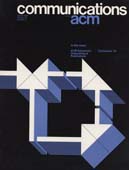March 1979 - Vol. 22 No. 3

Features
Contained in this report are the recommendations for the undergraduate degree program in Computer Science of the Curriculum Committee on Computer Science (C3S) of the Association for Computing Machinery (ACM).
The core curriculum common to all computer science undergraduate programs is presented in terms of elementary level topics and courses, and intermediate level courses. Elective courses, used to round out an undergraduate program, are then discussed, and the entire program including the computer science component and other material is presented. Issues related to undergraduate computer science education, such as service courses, supporting areas, continuing education, facilities, staff, and articulation are presented.
FOCUS microcomputer number system
FOCUS is a number system and supporting computational algorithms especially useful for microcomputer control and other signal processing applications. FOCUS has the wide-ranging character of floating-point numbers with a uniformity of state distributions that give FOCUS better than a twofold accuracy advantage over an equal word length floating-point system. FOCUS computations are typically five times faster than single precision fixed-point or integer arithmetic for a mixture of operations, comparable in speed with hardware arithmetic for many applications. Algorithms for 8-bit and 16-bit implementations of FOCUS are included.
Experiments with some algorithms that find central solutions for pattern classification
In two-class pattern recognition, it is a standard technique to have an algorithm finding hyperplanes which separates the two classes in a linearly separable training set. The traditional methods find a hyperplane which separates all points in one class from all points in the other, but such a hyperplane is not necessarily centered in the empty space between the two classes. Since a central hyperplane does not favor one class or the other, it should have a lower error rate in classifying new points and is therefore better than a noncentral hyperplane. Six algorithms for finding central hyperplanes are tested on three data sets. Although frequently used in practice, the modified relaxation algorithm is very poor. Three algorithms which are defined in the paper are found to be quite good.
An extended form of semantic network is defined, which can be regarded as a syntactic variant of the clausal form of logic. By virtue of its relationship with logic, the extended semantic network is provided with a precise semantics, inference rules, and a procedural interpretation. On the other hand, by regarding semantic networks as an abstract data structure for the representation of clauses, we provide a theorem-prover with a potentially useful indexing scheme and path-following strategy for guiding the search for a proof.
The use of normal multiplication tables for information storage and retrieval
This paper describes a method for the organization and retrieval of attribute based information systems, using the normal multiplication table as a directory for the information system. Algorithms for the organization and retrieval of information are described. This method is particularly suitable for queries requesting a group of information items, all of which possess a particular set of attributes (and possibly some other attributes as well). Several examples are given; the results with respect to the number of disk accesses and disk space are compared to other common approaches. Algorithms evaluating the appropriateness of the above approach to a given information system are described. For a certain class of information systems, the normal multiplication table method yields far more rapid retrieval with a more economical space requirement than conventional systems. Moreover this method incorporates an improved modification of the inverted file technique.



